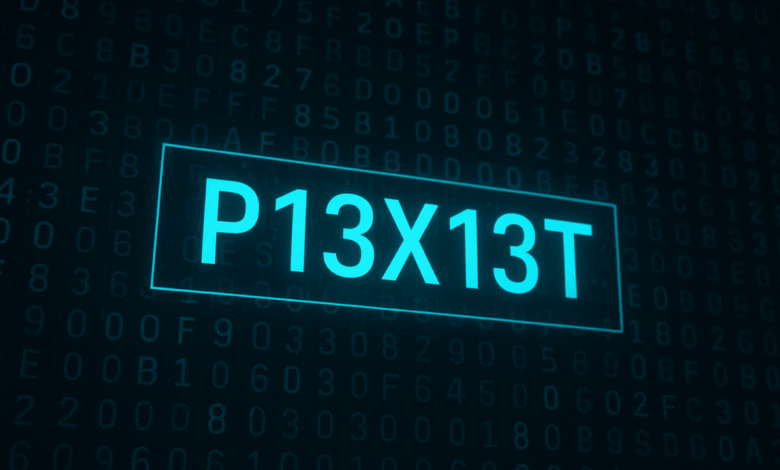P13x13t: The Mysterious Digital Code Revolutionising Modern Technology

In the digital age, new codes, frameworks, and identifiers emerge every day, often shrouded in mystery and speculation. One such term that has recently caught the attention of tech enthusiasts and digital analysts is p13x13t. Despite its cryptic appearance, p13x13t has been associated with concepts like encryption, digital watermarking, artificial intelligence (AI), and algorithmic identity systems. This article explores what p13x13t is, its possible meaning, applications, and future implications in the tech world. Whether it’s a real algorithmic breakthrough or a symbolic digital phenomenon, p13x13t continues to intrigue online communities and technology watchers alike.
What is p13x13t?
The p13x13t is an alphanumeric string that appears to follow a structured pattern: “p + 13 + x + 13 + t.” On the surface, it may seem like a random mix of letters and numbers. However, sources across multiple tech blogs and conceptual analysis platforms suggest that p13x13t could represent an encoded framework — a type of symbolic identifier with algorithmic or encryption-based properties.
While there is no officially verified definition, discussions around p13x13t have centred on the idea that it could be:
- A prototype code for a digital watermarking system,
- A symbolic identifier for an artificial intelligence model or dataset,
- A test signature for algorithmic traceability,
- Or even a meta-framework used for embedding digital authenticity into online content.
The structure of the term itself (with the repetition of “13”) gives it a unique signature, which some speculate could represent binary symmetry or encryption keys in programming.
The Origins of p13x13t
The first references to p13x13t appeared on smaller UK-based technology websites in the early 2020s. These sites described it as an emerging concept combining pattern recognition, security enhancement, and algorithmic identity tagging.
Although mainstream technology outlets such as Wired, TechCrunch, and The Verge have not covered it, several niche digital publications have explored its potential significance. Some writers even interpret p13x13t as a symbolic construct representing the intersection of privacy, data security, and digital authenticity — core values in modern information technology.
Given the secrecy and ambiguity around its origin, p13x13t could have started as a private research project code name or AI testing identifier that gradually entered online discourse.
Decoding the Structure of p13x13t
Let’s break down the p13x13t to analyse its potential meaning:
- “P” may represent “Project,” “Protocol,” or “Pattern.”
- “13” could denote a version number, batch identifier, or even a cryptographic key reference.
- “X” is often used as a mathematical symbol for an unknown variable or a multiplier.
- The second “13” might emphasise duality or iteration, possibly referring to a repeated pattern or a data loop.
- “T” could signify “Technology,” “Test,” or “Token.”
When taken together, p13x13t could hypothetically mean “Project 13 by 13 Token” or “Patterned 13×13 Test.”
This suggests the term might refer to a patterned, algorithmic grid, linked to AI models or data-mapping systems.
Possible Applications of p13x13t in Technology
Even though p13x13t is not officially defined in open-source databases or academic literature, its conceptual framework could be applied to several modern technology areas. Let’s explore these possibilities:
Digital Watermarking and Authenticity Verification
With the rapid rise of AI-generated content, deepfakes, and misinformation, digital authenticity has become a crucial concern.
If p13x13t functions as a watermarking or signature system, it could be embedded in media files, ensuring traceability and confirming content origins. Such a technology could be instrumental in:
- Tracking the authenticity of videos, images, and music,
- Preventing data tampering,
- Authenticating NFTs and blockchain assets.
Encryption and Data Security
The repeated numeric structure in p13x13t suggests cryptographic potential. It might represent a layered encryption method where dual values (13×13) form part of a key matrix.
This concept could strengthen multi-level encryption protocols, providing additional security for digital communications and file storage.
Artificial Intelligence and Machine Learning
AI models rely on identifiers and dataset tagging for structured learning. p13x13t could be used as a machine learning identifier, to label data clusters, or to represent pattern-recognition sets.
It may also serve as a synthetic label for generative AI models, especially those trained on anonymised or patterned data.
Algorithmic Identity and Blockchain Technology
Blockchain systems depend on unique hash codes to secure transactions. p13x13t could serve as a hash-like code for decentralised identity management.
If tied to blockchain, it might enable:
- Immutable digital IDs,
- Verifiable digital credentials,
- Traceable smart contracts, and
- Secure cross-platform asset verification.
Why p13x13t Has Gained Online Attention
The growing discussion around p13x13t can be attributed to its mysterious yet technical aesthetic.
In an age where every online entity leaves a digital footprint, a code like p13x13t resonates with both technologists and digital philosophers as a symbol of encrypted identity.
It represents the fascination with secrecy and systematisation — the idea that even random codes might hide complex meaning. Moreover, with AI tools, cybersecurity, and data ethics dominating public discourse, p13x13t fits naturally into conversations about digital trust and traceability.
Symbolic Interpretations of p13x13t
Apart from technical implications, p13x13t has also taken on symbolic interpretations in digital art and design.
Some digital artists and creators view it as a metaphor for human–machine integration, where randomness and precision coexist. The recurring numeric pattern (13×13) could signify balance within complexity, suggesting that every piece of data — no matter how chaotic — has a deeper structure.
This symbolic allure makes p13x13t a topic of interest not only in tech communities but also in digital philosophy and modern aesthetics.
Criticism and Scepticism Around p13x13t
Despite the growing attention, p13x13t faces its share of scepticism. Critics argue that:
- No academic evidence or technical documentation verifies its authenticity as a technology or framework.
- The information about it is mostly speculative and unverified, originating from minor blogs or promotional pages.
- It might be a marketing strategy or conceptual art project rather than a genuine algorithmic innovation.
These criticisms are valid, as genuine cryptographic or AI technologies are usually supported by published research, patents, or open-source repositories — none of which currently exist for p13x13t.
Future Prospects of p13x13t
Whether real or symbolic, p13x13t sparks discussions about the future of data integrity and digital identity. If it represents an actual framework under development, we may see its principles emerge in:
- AI model transparency protocols,
- Secure digital content tagging systems, or
- Blockchain-based verification tools.
On the other hand, if p13x13t is a conceptual creation, it still holds philosophical value — reminding us that every code, symbol, or dataset reflects humanity’s ongoing quest to merge creativity and computation.
Conclusion: The Enigma of p13x13t
In conclusion, p13x13t remains an enigmatic keyword at the crossroads of technology, symbolism, and digital culture. While its true origin and definition are uncertain, the term embodies modern fascination with encrypted identities, pattern recognition, and technological evolution.
You May Also Read: Znxnz: The Next Big Thing in Tech, Culture, and Digital Innovation




